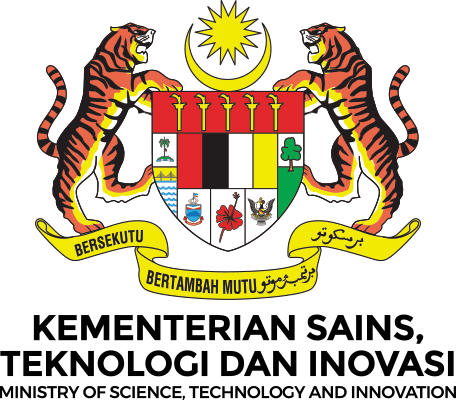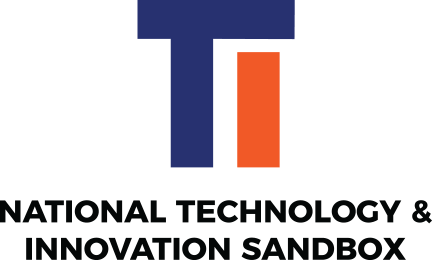Economic Recovery Through Innovation: Malaysia’s Emerging Ecosystem Battles Back
Effective leadership, interagency collaboration and thinking-outside-the-box are a strong foundation on which to build a country’s response to health and economic risk. Dr Alan Downe of Fourth Leap interviews two dynamic leaders on overcoming challenges, being resilient, and innovating during these trying times.
“The era of COVID-19 can be an unavoidable lesson in how to pivot and fight back through innovation, and how to power onward with human ingenuity.” - Datuk Ir Dr Siti Hamisah binti Tapsir, Secretary-General of the Ministry of Science, Technology & Innovation (MOSTI)

The Year 2020 will go down in history as a time when the spread of the SARS-CoV-2 virus reached pandemic proportions and threw the world into deadly health crises, economic uncertainty and a “New Normal” rife with uninvited lifestyle changes. Recent progress in vaccine development and effective mitigation efforts have brought some welcome light to the end of the tunnel. But experts still warn that the pandemic is far from over.
Malaysia has not fared as badly as many other parts of the world but is finishing the year in the throes of a COVID-19 Third Wave. Daily reports of new cases hover around four figures and the country’s cumulative death toll is now more than 400. Economic effects threaten to be as devastating to national well-being as the disease. Altered consumer spending patterns, business closures and workforce disruption have hit hard at key sectors like airlines, tourism, retail, and entertainment. By late September, the World Bank was forecasting a 4.9% contraction in economic growth, as measured by real GDP.
Even in this dire scenario, a quick and effective response from Malaysia’s Government has impressed most local and international observers alike. As early as mid-March, steps were taken to break the chain of infection through movement control mandates and public communication. Malaysia also moved promptly to reduce negative economic effects. The Government has now released four economic stimulus packages. Its most recent, the RM35 billion (USD8.6 billion) Pelan Jana Semula Ekonomi Negara (PENJANA), is primarily aimed at helping affected businesses and families recover from economic disruption during the pandemic.

Sure, there have been challenges, some populist non-compliance and a bit of political theatre at various junctures in Malaysia’s COVID-19 story but, most acknowledge that sound public sector headship has driven some reasonably good policy and effective intervention. A new highly-adaptive, innovation-focused ecosystem is emerging. Three key IR4.0 concepts are at the core.

Business sustainability is being able to persevere in the face of inevitable challenges
Recovery Vision Leveraging Existing Ecosystem Strength
If one theme has predominated the Government’s PENJANA package, it is that innovation is the core ingredient to finding our way out. Among the 40 or so initiatives contained within the Plan, each represents a commitment to “new thinking”.
Perhaps the most ambitious of these is the impressive National Technology and Innovation Sandbox (NTIS) initiative, spearheaded by the Ministry of Science, Technology and Innovation (MOSTI). Leadership powerlifting on this one has fallen primarily to Datuk Ir Dr Siti Hamisah binti Tapsir, the Ministry’s Secretary-General. An accomplished Civil Engineer, she is a seasoned veteran of senior university posts and has held top management roles in the Department of Higher Education and the Ministry of Energy, Science, Technology, Environment and Climate Change (MESTECC).
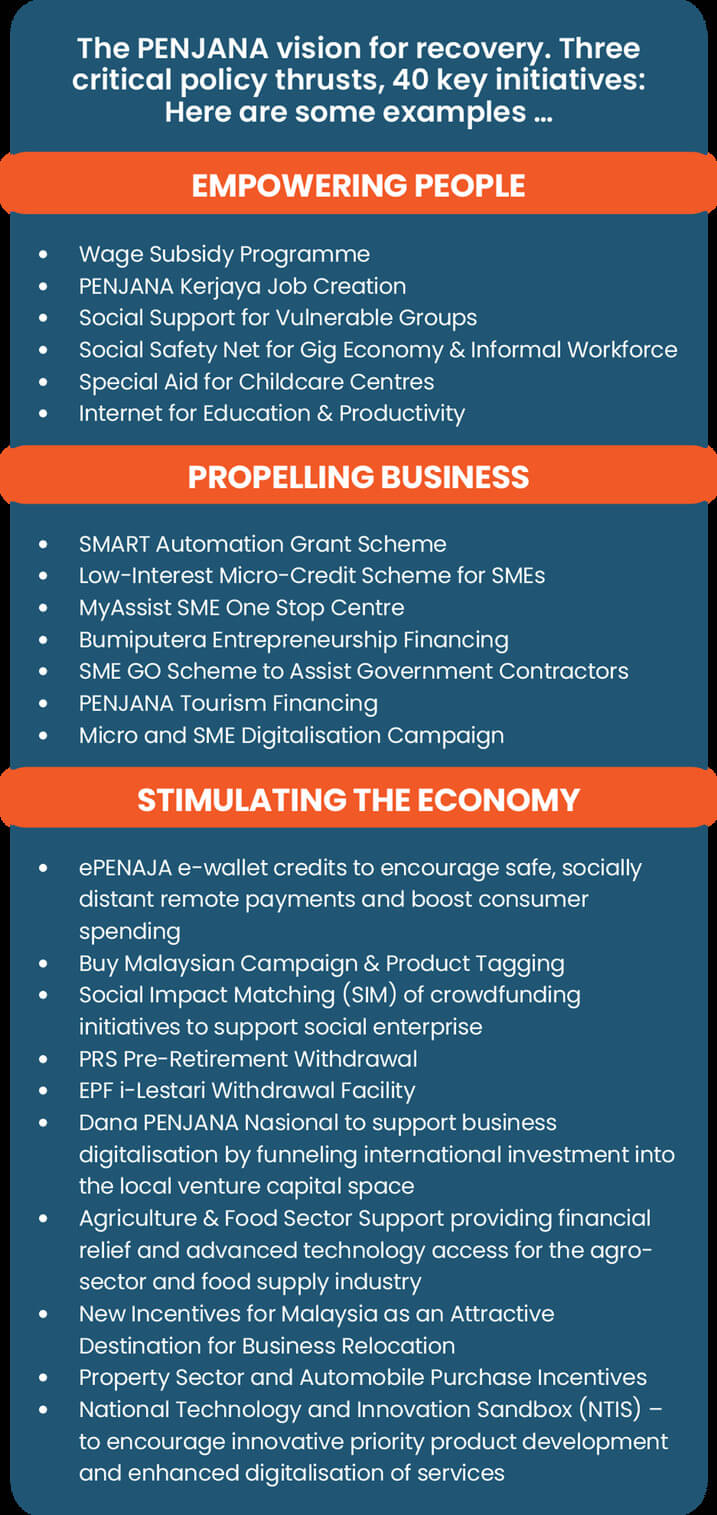
Dr Siti Hamisah assumed her new post at MOSTI in March 2020, just as the World Health Organization (WHO) classified COVID-19 as a global pandemic. The world plunged into unprecedented volatility, uncertainty and risk. Events called immediately for a new Malaysian vision built on an appreciation of science and technology. Recently Dr Siti Hamisah told Fourth Leap, “The human race is facing the biggest crisis since World War II and everyone has to reassess their priorities to ensure survival in this new world. I do mean everyone – from governments to large multinationals and local SMEs, and from tech-enabled start-ups to conglomerates. Everyone.”
“But it is also during periods like these that some of the world’s most defining solutions for humankind have emerged. For us, the era of COVID-19 can be an unavoidable lesson in how to pivot and fight back through innovation, and how to power onward with human ingenuity.”
The decision to place ingenuity at the cornerstone of MOSTI’s vision for national recovery makes sense. Malaysia already has a sound reputation as an emerging and thriving innovation environment. The country was ranked in the Top 10 Emerging Ecosystems in Performance and in the Top 20 Emerging Ecosystems in Talent, according to the Global Startup Ecosystem Report 2020 (GSER2020).
It ranked eighth in Asia and 33rd overall in the Global Innovation Index (GII) 2020 report released in September 2020 by the World Intellectual Property Organisation (WIPO).
Malaysia also came 27th out of more than 200 countries on the Bloomberg Innovation Index 2020. Germany ranked first, South Korea second and Singapore third.
Under Dr Siti Hamisah’s guidance, MOSTI has represented innovation as the key to the nation’s economic recovery and beyond. Just a few months ago, Ministry leadership presented a paper to Malaysia’s Economic Council titled, Transforming Malaysia, Fast Forward Malaysia: Accelerating Technology Adoption. In it, they argued for greater urgency in solving current challenges and proposed a number of prospective directions.
Undoubtedly, some structural weaknesses do persist. According to Dr Siti Hamisah, there can be disappointing shortfalls in private sector investment and low or uneven commercialisation rates. Regulatory “red tape” and an over-reliance on foreign talent for high-tech solutions also hinder headway in meeting goals for industrial development. “In the past, local tech adoption has been vendor-driven, where Government and private sector entities procure solutions on a need-basis. Developed in silos, we’re left with a reality where solutions are incompatible with the larger ecosystem. That drags down future innovation.”
“This simply can’t happen in the new norm, where innovation, creativity and agility are our main defences against widespread disruption. Malaysia needs a holistic plan for innovation.”
And a plan is indeed underway. The National Policy on Science, Technology and Innovation (DSTIN) 2021-2030, launched by the Minister of Science, Technology and Innovation on 8 December 2020, is designed to transform the country from being mostly tech users to tech developers. Through MOSTI, the government addresses innovation inefficiencies and foreign technology dependency while introducing the concept of Science, Technology, Innovation and Economy (STIE), based on 30 niche areas as endorsed by the National Science Council chaired by the Prime Minister in July 2020.
STIE’s 10 Technology Drivers on 10 Socioeconomic Drivers (10-10) Science, Technology, Innovation and Economy (MySTIE) Framework, coupled with six cores, 20 strategies and 46 initiatives of the policy will be key to enable a vibrant and agile National STI Ecosystem.
These six cores revolve around empowering research and development, commercialisation and innovation; the use of local technology; responsive STI governance; STI talent development; embracing and applying STIE as well as bringing STI to the global arena. While Malaysia remains a competitive nation in the region, much effort is needed to increase the level of competency and innovative output to justify its high investment input. This plan will secure the nation’s success in the coming years and in the era of the Fourth Industrial Revolution.
Dr Siti Hamisah pointed out that MOSTI and its agencies like the Malaysian Global Innovation & Creativity (MaGIC) Centre, have already been racing fast to reach the country’s future technology goals. In 2019 alone, for instance, over 20,600 individuals participated in MaGIC’s various programmes nationwide. These included design thinking and innovation workshop training, boot camp and accelerator start-up programmes, and strategic tie-ups and collaborations with private sector firms, corporates, universities and other ecosystem partners.
Earlier this year, MaGIC took the unparalleled step of sharing its own data and ecosystem management platform as a new open-source platform called OpenHub, making it accessible to anyone in the start-up community – government agencies, private accelerator providers or even community leaders – who wanted to begin managing their own data-driven ecosystem strategy.
Experimentation and Agile Mindset. Welcome to the NTIS Sandbox
Success in the Fourth Industrial Revolution is all about leadership. Gerald C. Kane, a professor of Information Systems with the Carroll School of Management at Boston College conducted a study where he identified the most common leadership traits of the world’s best digital leaders. Writing in the MIT/Sloan Management Review, he found remarkable constancy across the various digital maturity levels of organisations he sampled, with executives almost universally preferring to be led by people with high scores in eight specific competencies. Dr Siti Hamisah would excel in all eight.
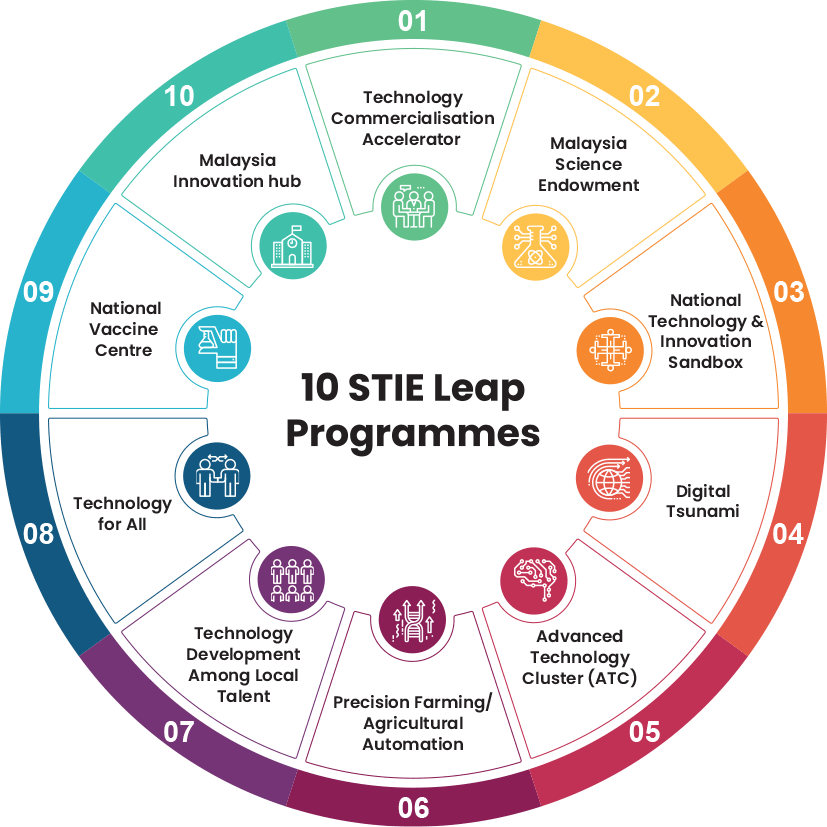
Prof Kane found that good digital leaders get people to think differently and to become comfortable working outside the proverbial box. Creating conditions where people are motivated to experiment and are permitted to go beyond the boundaries defining a problem is part of an essential leadership toolkit for IR4.0 trailblazers. That’s the idea, too, on which a Regulatory Sandbox innovation model is based.
MOSTI’s flagship PENJANA initiative, the National Technology and Innovation Sandbox (NTIS), has a RM100 million (USD24.6 million) budget to accelerate the creation, commercialisation and expansion of advanced technologies to fast-track Malaysia’s recovery from COVID-19 and its progress toward becoming a high-tech nation. The programme offers local innovators opportunities to test products and solutions in a conducive and less-controlled environment, greatly shortening the path from testing to commercialisation.
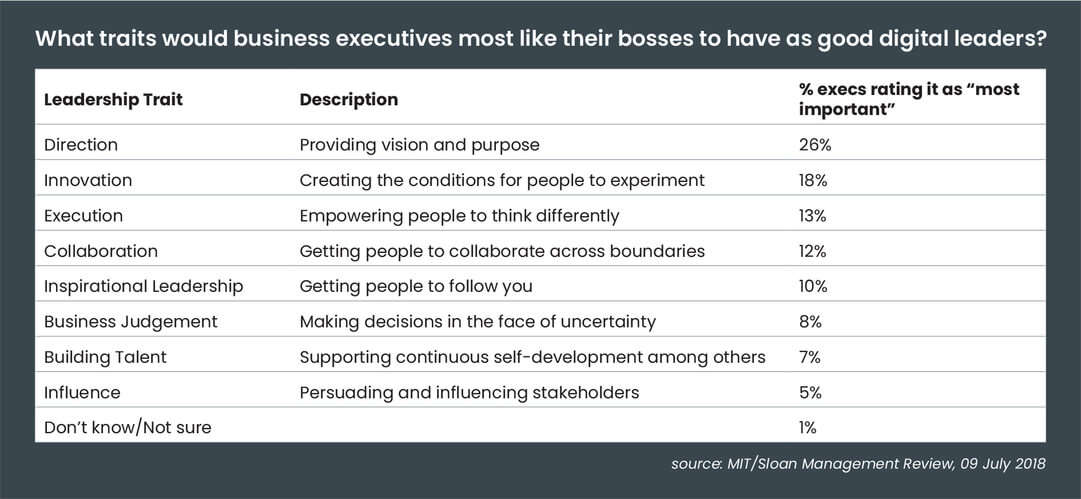
Project governance lies with MOSTI and the initiative is managed by a multi-Agency secretariat led by MaGIC and its talented CEO, Dzuleira Abu Bakar. The Secretariat is charged with the coordination and implementation of key projects.
Dr Siti Hamisah and Dzuleira elaborated that the Secretariat consists of various government agencies involved in Malaysia’s innovation ecosystem including MaGIC, which will lead the group and act as a central repository for ideas, solutions and intellectual property; Malaysia’s National Applied Research and Development Centre (MIMOS) and Technology Park Malaysia (TPM), which will identify new solutions, run technology audits and facilitate certification processing; FUTURISE, which will take on the regulatory components of the Sandbox; and the Malaysian Technology Development Corporation (MTDC), the main funding partner for the sandbox.
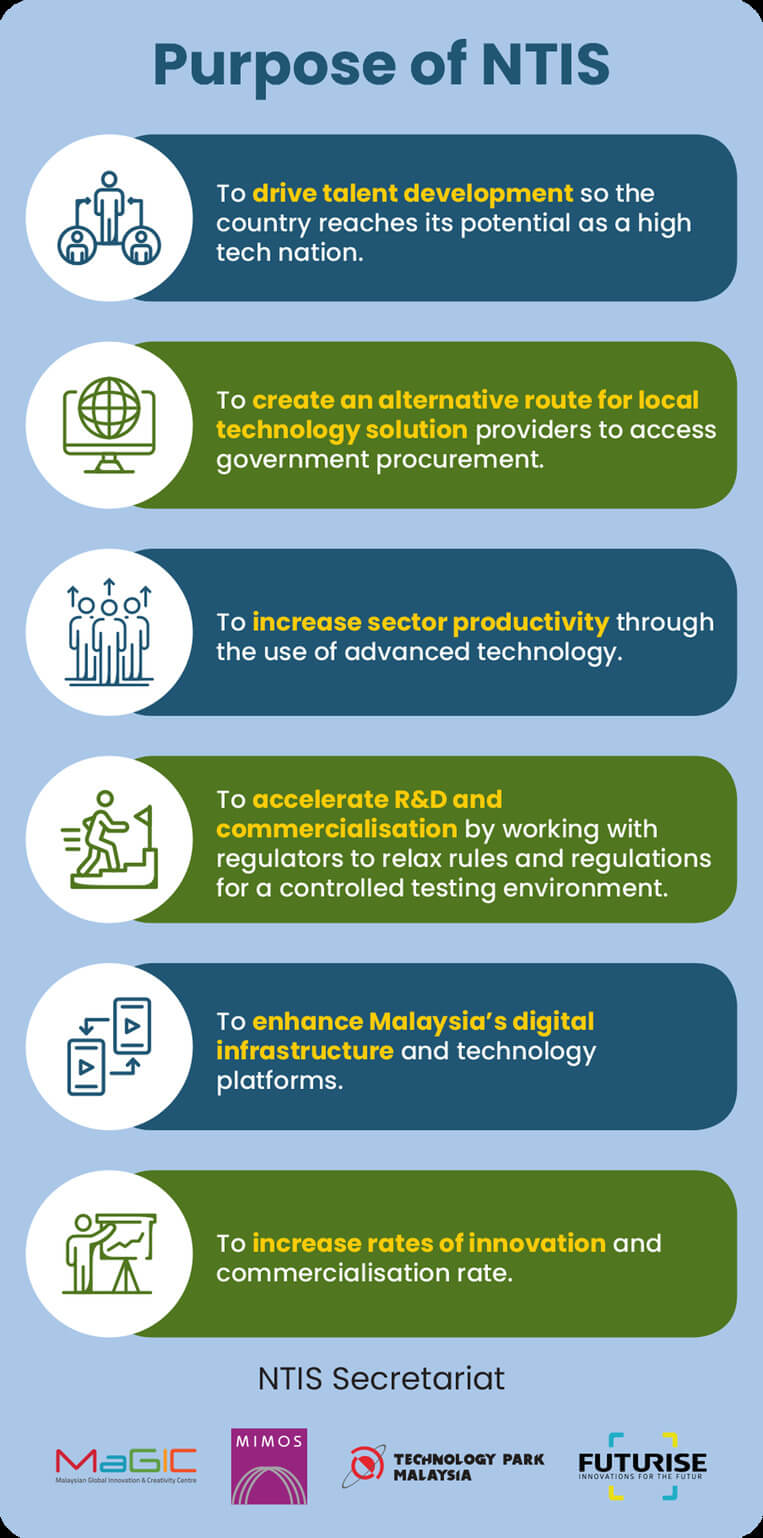
It should be noted that, internationally, the Regulatory Sandbox concept has been around for a while. It originated in 2016 as a pilot project with the UK Financial Conduct Authority (FCA), which defined it as, “a ‘safe space’ in which businesses can test innovative products, services, business models and delivery mechanisms without immediately incurring all the normal regulatory consequences of engaging in the activity in question.”
In other words, in the Sandbox, the development of selected projects is supported by setting aside certain regulatory performance and reporting requirements. This less fettered creative process offers innovators broader scope and precious time for experimentation with new ideas. It allows greater agility, speed and integration during the proof of concept and prototyping phases, and results in shorter time frames to get solutions up and running.
The model gained slow but steady acceptance around the world, with most use-cases focused on the development of new financial engineering technologies and digitally-mediated financial services. In Malaysia, the model has been recognised as a promising fintech enabler since it was rolled out in February 2018. But Malaysia was also poised to be one of only a few countries planning to use the Sandbox in non-financial verticals, including healthcare, waste management, transportation and energy.
Urgent Times, Rapid Progress
In 2020, though, COVID-19 created a critical need for innovation. NTIS was immediately seen as a vehicle to address resulting health and economic concerns. Dr Siti Hamisah noted, “Prioritisation is key to the nation’s stable recovery from this pandemic. Finding pandemic-related solutions allows recovery to be resilient enough to tackle other significant needs, such as waste management and recycling, automated business processes and autonomous vehicles.” But these may have to be targeted for later. The present focus is on relief.
Dzuleira proudly reports that the initiative is now well underway. In December, MaGIC received over 1,834 applications for NTIS, spanning key sectors such as healthcare, agriculture, financial services, manufacturing, education, SMART cities and many more. All proposed solutions have to be at Technology Readiness Level (TRL) 6. TRL is a method, developed at NASA, for estimating the maturity of technologies during the acquisition phase of a programme.
From the initial application and screening process, six pilot projects have already been identified to kick-start the NTIS. These include:
- a lightweight mobile robot deployed in agriculture to increase work efficiency and reduce the numbers of workers required
- an easily scalable, first-of-its-kind semi-ventilator to assist patients with breathing difficulties
- a robot to assist the recovery process of stroke patients or other medical conditions involving impaired or limited limb function
- a drone solution to automate high-precision spraying of pesticides, saving time and cost in the agriculture sector and providing safeguards for food supply chains under pressure
- pick-and-place linear robots for use in manufacturing, reducing disease transmission by reducing numbers of factory workers, while increasing productivity, efficiency and production quality
All are solutions that will reduce potential exposure to the virus, enhance food security and assist in medical treatment. Dzuleira points out that NTIS also pays increased attention to the products’ business case that will drive economic recovery.
“Sustainability is often misunderstood and seen to be some grand fuzzy concept. In actual fact, it ensures that every part of your business aligns to the ability to persevere, even in the face of inevitable challenges such as we face now. This puts in place a stronger foundation for the future, as we prepare to bounce back from the devastating impact of COVID-19.”
“A sustainable business brings in the right kind of ROI, the kind of ROI the world is going to need to emerge from this crisis.”
NTIS through MaGIC, collaborated with FELDA recently to:
- Increase the average income of FELDA settlers, through reducing farm operating costs or increasing farm yields;
- Diversify activities in the FELDA plan to create high-value economic opportunities and employment for the new generations of FELDA;
- Drive the development of talent to achieve the potential of becoming a high-tech country;
- Accelerate the R&D and commercialisation process with the cooperation of the regulator (i.e CAAM);
- Increase the rate of commercialisation and innovation.
Five high-technology companies had been selected to stress-test various drone and robotic solutions to improve aspects of harvesting, maintenance and fertilisation of palm oil plantations at two selected FELDA Mempaga implementation sites in Pahang, totalling 25 hectares.
Furthermore, MaGIC signed a Memorandum of Understanding with IIB Ventures, a wholly-owned subsidiary of Iskandar Investment Berhad, and with DHL in Iskandar Malaysia to establish the first Drone and Robotics Zone in Southeast Asia. DRZ Iskandar, as the next sandbox testbed under NTIS, will see the conception of a controlled drone and robotics ecosystem to accelerate the creation of local innovations and become a growth engine, talent hub and tech leader for Malaysia and the Asia-Pacific region.
“A sustainable business brings in the right kind of ROI, the kind of ROI the world is going to need to emerge from this crisis.” - Dzuleira Abu Bakar, CEO of Malaysian Global Innovation & Creativity Centre (MaGIC)

Surmounting Challenges through Collaboration and a Digital Mindset
It has to be said. Sandbox models have their detractors. In early FCA trials, regulatory traditionalists and consumer groups expressed concern about relaxing standards during the product development cycle, particularly for digital fintech and medical devices. A former New York State Department of Financial Services Superintendent famously quipped that “Toddlers play in sandboxes. Adults follow the rules.”
At the other extreme, industry players sometimes feared that gung-ho regulators hosting the sandbox might impose even more restrictive conditions on the development process than in the waived legislation and that progress could be prone to bog down in Ministerial silos.
With NTIS, these conflicts have not arisen. Collaboration and boundaryless communication are the reasons. Dzuleira points to the shared vision within the Secretariat and to the team spirit common to all players. In Malaysia, most governments long ago embraced, at least in principle, the journey to digital transformation. A first-rate Government as a Platform (GaaP) portal, cutting-edge data management systems and successful high-level training through the Digital Government Competency & Capability Readiness (DGCCR) programme and others have inculcated a digital mindset within the public service. Agile project management, cross-functional teams and a commitment to open, honest collaboration goes a long way to ensuring successful outcomes.
For Dzuleira, this is personal. “I aspire to mould Malaysia’s next generation of entrepreneurs to navigate the risks of today and challenges of tomorrow, in preparation for future and rapid change brought about by IR4.0. I know we can do it.”
It is personal for Dr Siti Hamisah too. “This pandemic is going to leave a lasting stain on our DNA as a nation. But this worldwide crisis has also presented us with the opportunity to accelerate change that a lot of governments have put off in terms of empowering people, propelling business and stimulating the economy. These are changes we all should have embraced long ago – digitisation, digitalisation, automation and robotics.” Now we have another chance. It’s going to be exciting.
